Sorry I’m so late with this. Had the darndest time with Ca’ Corner della Regina, as, unfortunately, photographs were not allowed (the photos are all from the Web), and I misspelling most of the artists’ names in my cursory notes. Couldn’t have done it without Russ’ help; he knows the artists better than I do. (When I was working on MART he even wrote the curator at the museum and got an immediate response with the artist’s name, Luca Pozzi, who took a photo of an old master with a tossed orange.)
Saturday morning, June 15, 2013
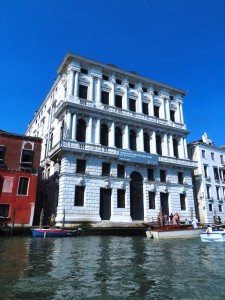 Boat to Fondazione Prada’s Ca’ Corner della Regina, an historic palazzo on the Grand Canal, for the exhibition When Attitudes Become Form: Bern 1969/Venice 2013.
Boat to Fondazione Prada’s Ca’ Corner della Regina, an historic palazzo on the Grand Canal, for the exhibition When Attitudes Become Form: Bern 1969/Venice 2013.
The original show in Switzerland was curated by Harald Szeemann at the Bern Kunsthalle(art exposition hall) in 1969.
Swiss curator Harald Szeemann had sparked outrage throughout Bern. Artists in tractors deposited piles of manure in front of the Kunsthalle, while indoors, Richard Serra splashed molten lead onto a wall. [My note says 200K ??? molten lead not allowed at the palazzo hence photo + dots.] But the real scandal of the exhibition was not this type of action – it was the new form of artistic process it embraced and its monumental claim to freedom.1
The Venice 2013 version has been curated by Germano Celant with German sculptor and photographer Thomas Demand and Dutch architect Rem Koolhas. (Side note: The Fondazione Prada is working with Rem Koolhaas on an exhibit space in an industrial complex in Milan to explore the relationship between art, contemporary architecture and the recovery of an industrial area of historical importance. It should be inaugurated this year. I gather some of this art shall be in a permanent collection there.)
To present, today, an exhibition from 1969… has posed a series of questions on the complexity and very meaning of the project, which has developed through a profound debate from various perspectives: the artistic, the architectural and the curatorial… it has been decided to graft the exhibition in its totality—walls, floors, installations and art objects, including their relative positions—onto the historical architectural and environmental structure of Ca’ Corner della Regina, thereby inserting—on a full-size scale—the modern rooms of the Kunsthalle, delimited by white wall
surfaces [note the photo showing the white wall board inserted over a column], into the ancient frescoed and decorated halls of the Venetian palazzo.
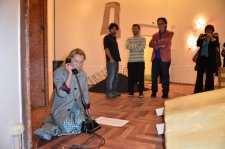 During the May opening event, artist Walter De Maria reenacted his famous artwork Art by Telephone, by calling the phone exhibited in the show. Miuccia Prada was the first person to answer. (I liked his Lightning Field better! Both are performance art, but you don’t have to travel to Quemado, New Mexico and stay at one of the cabins, waiting for lightning – you can see photos!)
During the May opening event, artist Walter De Maria reenacted his famous artwork Art by Telephone, by calling the phone exhibited in the show. Miuccia Prada was the first person to answer. (I liked his Lightning Field better! Both are performance art, but you don’t have to travel to Quemado, New Mexico and stay at one of the cabins, waiting for lightning – you can see photos!)
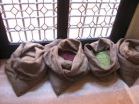 Jute sacks of coal, corn and peas, Untitled, in corridor, by Jannis Kounellis. Post-minimal.
Jute sacks of coal, corn and peas, Untitled, in corridor, by Jannis Kounellis. Post-minimal.
Mario Merz’s Water Slips Down (Glass Igloo), and Gilberto Zorio’s Torches, made from reeds, 4 torches, cement powder, copper clamps. The 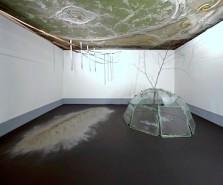
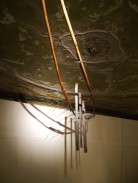 reeds are the horizontals near the ceiling, the four torches (which can’t be lit because no fires allowed in this palazzo) are the white verticals hanging down (see detail), cement powder on the floor which I guess represents ashes from the torches?
reeds are the horizontals near the ceiling, the four torches (which can’t be lit because no fires allowed in this palazzo) are the white verticals hanging down (see detail), cement powder on the floor which I guess represents ashes from the torches?
Giovanni Anselmo’s Torsion, which looks like a mop twisted.
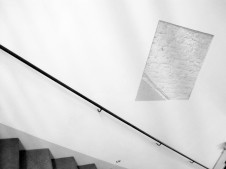
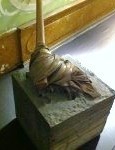 Lawrence Weiner’s A 36” x 36” Removal to the Lathing or Support Wall of Plaster or Wallboard from a Wall.
Lawrence Weiner’s A 36” x 36” Removal to the Lathing or Support Wall of Plaster or Wallboard from a Wall.
Joseph Beuys’ Fat Corner, margarine smeared along wall plus a triangle and square in corner.
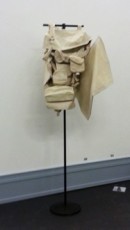 Claes
Claes 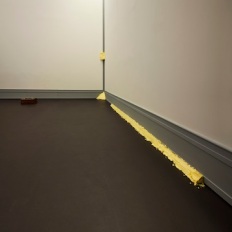 Olden- burg’s piece, which looks like a canvas back- pack on a hanger, is titled Model (Ghost) Medicine Cabinet, made from plastic, paint, canvas, wood, kapo. I don’t care for his soft works.
Olden- burg’s piece, which looks like a canvas back- pack on a hanger, is titled Model (Ghost) Medicine Cabinet, made from plastic, paint, canvas, wood, kapo. I don’t care for his soft works.
Oldenburg’s works fasten on common motifs of everyday life to act as medium in structural or surface experiments—the bathroom, the bedroom, the kitchen, the automobile. Oldenburg has … produced his own bathroom with sagging, vinyl potty and sink and medicine chest. He has rendered “soft” automobile parts, pillowy engine blocks big as sides of beef, in kapok-filled canvas.2
 I love his oversized renditions of ordinary objects, such as Spoonbridge and Cherry, the giant spoon stretching 52 feet across a small pond, and his 17-foot-high Shuttlecock.
I love his oversized renditions of ordinary objects, such as Spoonbridge and Cherry, the giant spoon stretching 52 feet across a small pond, and his 17-foot-high Shuttlecock.
Alighiero Boetti’s Me Sunbathing in Turin, 111 pieces of hand-molded concrete, cabbage butterfly. (This, like the other black-and-white photos, is from the original show.)
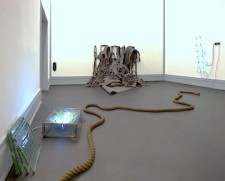
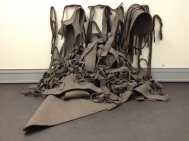 Two Space Rope Sculpture by Barry Flanagan; here one of the two ropes. On the back wall Felt by Robert Morris was done for the site then destroyed in ‘69; it was recreated for this show. On the right wall
Two Space Rope Sculpture by Barry Flanagan; here one of the two ropes. On the back wall Felt by Robert Morris was done for the site then destroyed in ‘69; it was recreated for this show. On the right wall 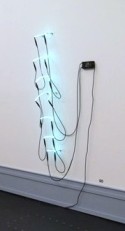 Neon Templates of the Left Half of My Body Taken at Ten Inch Intervals by Bruce Nauman.
Neon Templates of the Left Half of My Body Taken at Ten Inch Intervals by Bruce Nauman.
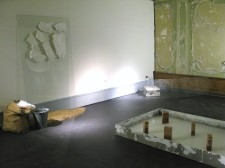 Giovanni Anselmo’s “Untitled” (floor, right) with galvanized metal, bricks, water, chalk. The Wet Cotton Is Thrown at the Glass and Remains There (left, wall) and “Untitled”, with stone, copper wire, electricity, in the corner.
Giovanni Anselmo’s “Untitled” (floor, right) with galvanized metal, bricks, water, chalk. The Wet Cotton Is Thrown at the Glass and Remains There (left, wall) and “Untitled”, with stone, copper wire, electricity, in the corner.
The wooden floor was brought from the Bern exhibition.
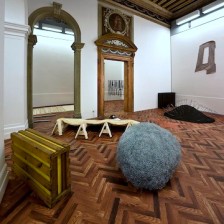 Gary B. Kuehn’s Untitled, wood, fiberglass, polyester resin, nails. The piece with the four sawhorses is another Gary Kuehn piece: Untitled (Wedge Piece). Next, this ball of wire is Alan Saret’s Zinc Fire. (He usually does looser wire confections.) The Eva Hesse piece is lurking beyond the arch on the left: it’s her Augment,
Gary B. Kuehn’s Untitled, wood, fiberglass, polyester resin, nails. The piece with the four sawhorses is another Gary Kuehn piece: Untitled (Wedge Piece). Next, this ball of wire is Alan Saret’s Zinc Fire. (He usually does looser wire confections.) The Eva Hesse piece is lurking beyond the arch on the left: it’s her Augment, 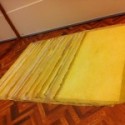 17 flat sheets of latex coated canvas spread out like playing cards on the floor.
17 flat sheets of latex coated canvas spread out like playing cards on the floor.
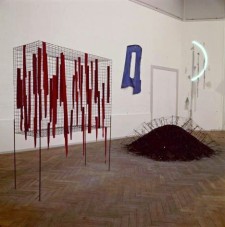 Reiner Ruthenbeck’s Moebel 1 (Furniture 1)made of strips of dark red cloth on a steel wire netting box on stilts, and his
Reiner Ruthenbeck’s Moebel 1 (Furniture 1)made of strips of dark red cloth on a steel wire netting box on stilts, and his 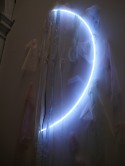 Ash heap 3, made of ashes, wire, 92 iron sticks. Above the ash heap, on the wall, Richard Tuttle’s Bow Shaped Light Blue Canvas, and on the wall at the right, Keith Sonnier’s Untitled (Neon and Cloth), a half curve of neon and silk.
Ash heap 3, made of ashes, wire, 92 iron sticks. Above the ash heap, on the wall, Richard Tuttle’s Bow Shaped Light Blue Canvas, and on the wall at the right, Keith Sonnier’s Untitled (Neon and Cloth), a half curve of neon and silk.
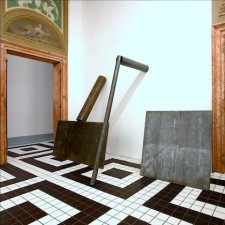 Richard Serra’s metal sheets and pipes balanced. Shovel Plate Prop, a plate and a tube of steel, Close Pin Prop, a pole and a tube of lead, and Sign Board Prop, a plate and a pole of lead with antimony.
Richard Serra’s metal sheets and pipes balanced. Shovel Plate Prop, a plate and a tube of steel, Close Pin Prop, a pole and a tube of lead, and Sign Board Prop, a plate and a pole of lead with antimony.
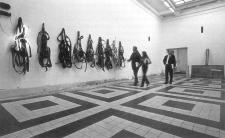 In the black-and-white photo, visitors to When Attitudes Become Form, 1969, Kunsthalle Bern , the hanging pieces, the lead corner splash (where the wall and floor meet), and the balanced sculpture to the right all by Richard Serra. Note that the floor tile has been recreated, of not the molten lead.
In the black-and-white photo, visitors to When Attitudes Become Form, 1969, Kunsthalle Bern , the hanging pieces, the lead corner splash (where the wall and floor meet), and the balanced sculpture to the right all by Richard Serra. Note that the floor tile has been recreated, of not the molten lead.
Carl Andre’s 36 Copper Square on the floor.
.
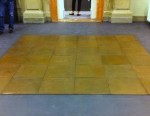
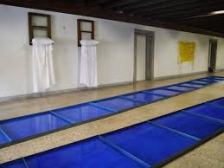 Third floor: Pino Pascali’s Confluences, 22 sheet iron boxes painted with blue anti-rust paint, in two lines, with aniline-colored water. Two of Marinus Boezem’s Window with wood, glass, clothes (which looked like a pillows and sheets).
Third floor: Pino Pascali’s Confluences, 22 sheet iron boxes painted with blue anti-rust paint, in two lines, with aniline-colored water. Two of Marinus Boezem’s Window with wood, glass, clothes (which looked like a pillows and sheets).
These three web sites were helpful.
>http://www.flashartonline.com/interno.php?pagina=articolo_det&id_art=672&det=ok&title=WHEN-ATTITUDES-BECOME-FORM
>http://lttds.blogspot.com/2013/06/part-33-55th-biennale-di-venezia.html
>http://www.numerocivico.info/events/fondazioneprada2013/index.htm
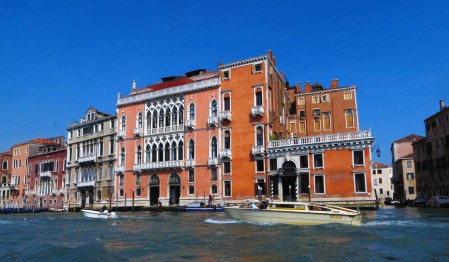 Boat to Palazzo Bembo to see Personal Structures.
Boat to Palazzo Bembo to see Personal Structures.
Roman Opalka (remember him, known for a quixotic project in which he sought to paint every number to infinity?) – three in sequence, one with a dark grey background, one light grey, and one white.
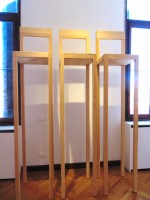
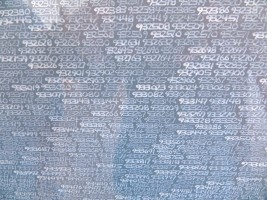 Michele Manzini’s chairs, The error and disenchantment.
Michele Manzini’s chairs, The error and disenchantment.
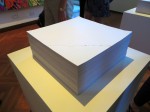
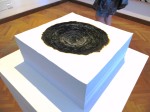 Chinese artist (秦冲) Qin Chong’s birthday, consists of four stacks of paper, each burned differently.
Chinese artist (秦冲) Qin Chong’s birthday, consists of four stacks of paper, each burned differently.
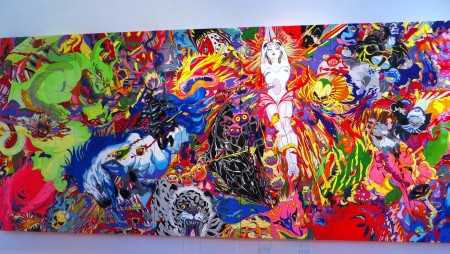 Yoshitaka Amano (天野 喜孝) is a Japanese artist well known for his illustrations and title logo designs for the Final Fantasy series. Here his comic book characters are taken to an art high.
Yoshitaka Amano (天野 喜孝) is a Japanese artist well known for his illustrations and title logo designs for the Final Fantasy series. Here his comic book characters are taken to an art high.
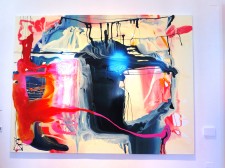 Australian artist Dale Frank’s A petulant tsunami of regrets and broken promises littered her chest drawer (yes, that’s the name of the work!) is a nice abstract with dripped paint.
Australian artist Dale Frank’s A petulant tsunami of regrets and broken promises littered her chest drawer (yes, that’s the name of the work!) is a nice abstract with dripped paint.
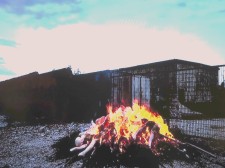
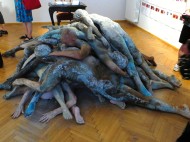 Yoko Ono’s Arising a Call takes up a whole room. First, there is a video of a mound of bodies burning, and you can hear her screaming. (This I found difficult to endure.) Then, in the center of the room, the silicon bodies, piled.
Yoko Ono’s Arising a Call takes up a whole room. First, there is a video of a mound of bodies burning, and you can hear her screaming. (This I found difficult to endure.) Then, in the center of the room, the silicon bodies, piled.
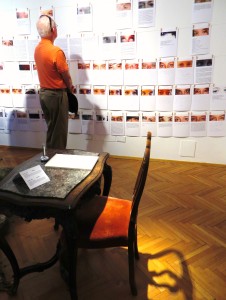 The walls are covered with testimonials of women who have been abused, with photos of their eyes. There is a desk so that women may continue to add to the exhibit.
The walls are covered with testimonials of women who have been abused, with photos of their eyes. There is a desk so that women may continue to add to the exhibit.
Women of all ages, from all countries of the world:
You are invited to send a testament of harm done
To you by men, for being a woman.
Write your testament in your own language,
In your own words, and write however openly you wish.
You may sign your first name if you wish,
But do not give your full name.
Send a photograph only of your eyes.
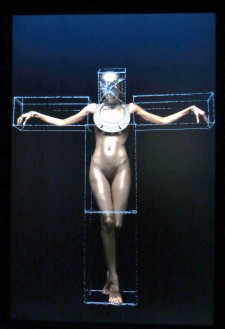
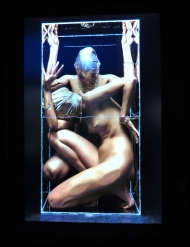 The life-sized photographs in Project NEO Omnia Vanitas (All is Vanity), of women in glass boxes wearing Egyptian jewelry, by the artists Vitaliy and Elena Vasilieva, have two themes, aesthetic and beauty.
The life-sized photographs in Project NEO Omnia Vanitas (All is Vanity), of women in glass boxes wearing Egyptian jewelry, by the artists Vitaliy and Elena Vasilieva, have two themes, aesthetic and beauty.
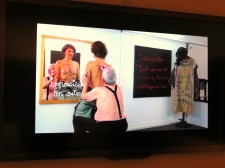
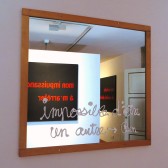 Next there’s Swiss artist Ben Vautier’s Introspection, Truth Art & Sex, many panels with pithy sentences, and a video of him writing on a woman, discussing truth, art and sex in French. I could see why you’d want to look at a naked woman, but I wish he’d put on a shirt! Then the same mirror in the video on the wall with impossible d’etre un autre > Ben (unable to be another > Ben) and reflected, nom impuissance a m’arreter (name impotence has me stop).
Next there’s Swiss artist Ben Vautier’s Introspection, Truth Art & Sex, many panels with pithy sentences, and a video of him writing on a woman, discussing truth, art and sex in French. I could see why you’d want to look at a naked woman, but I wish he’d put on a shirt! Then the same mirror in the video on the wall with impossible d’etre un autre > Ben (unable to be another > Ben) and reflected, nom impuissance a m’arreter (name impotence has me stop).
The Fluxus movement… developed its ‘anti-art’, anti-commercial aesthetics under the leadership of George Maciunas… Most of the experimental artists of the period, including Joseph Beuys, Yoko Ono and Nam June Paik, took part in Fluxus events. The movement, which still continues, played an important role in the opening up of definitions of what art can be. Ben Vautier was described as 100% Fluxman by George Maciunas.
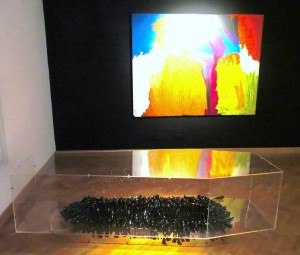 Australian Aboriginal artist Yhonnie Scarce, Blood on the Wattle, with 292 blown glass yams encased in an acrylic glass coffin.
Australian Aboriginal artist Yhonnie Scarce, Blood on the Wattle, with 292 blown glass yams encased in an acrylic glass coffin.
A lot of my work is inspired by personal experiences and particularly from family stories of what my grandparents went through as well. Looking at those effects of colonization and how it has affected Aboriginal people in Australia. Even though it’s 21st century we’re still having to deal with a lot of issues relating to how the first settlers viewed Aboriginal people when they first came to Australia and that’s to do with the issues of identity, racism, genocide and things like that.
The painting in the black wall by 89-year -old Mirdidingkingathi Juwarnda (Sally Gabori).
Sally Gabori…considered the major contemporary Aboriginal artist painting in Australia today. Colour and canvas became the catalyst for the creation of an entirely unique visual language; a way for Sally to explore life, landscape and memory.
German artist Otto Piene’s metal box with strobe, an exploration of light as an artistic and communicative medium.
Did Hirofumi Isoya do this painting, lit from behind?
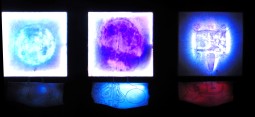
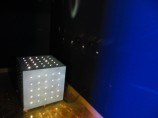 Johannesburg-based artist, Stefanus Rademeyer’s light-box Hexagrid, consists of nested hexagons that create a tessellation similar to that of a honeycomb, one of his Crystalline Variations.
Johannesburg-based artist, Stefanus Rademeyer’s light-box Hexagrid, consists of nested hexagons that create a tessellation similar to that of a honeycomb, one of his Crystalline Variations.
… is a Moroccan-Spanish-French artist who lives and works in Brussels and Paris. Born in France, the son of a Muslim father and a Catholic mother, is Lahlou grew up as a child with two religions. His work is characterized by a conscious identity but complex relationship and an ambiguous vision of our contemporary religious culture.
I think this sculpture of glass hands and feet on a prayer rug angled towards Mecca is his. (??)
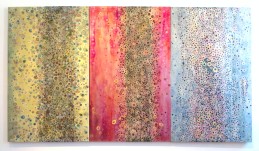 Laura Gurton’s painting, which I believe is of the Unknown Species series, reminds me of a mille de fleur glass paperweight. (My mother-in-law used to collect them.)
Laura Gurton’s painting, which I believe is of the Unknown Species series, reminds me of a mille de fleur glass paperweight. (My mother-in-law used to collect them.)
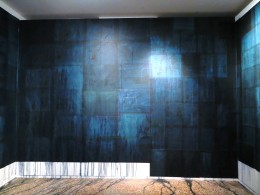 Austrian artist Jakob Gasteiger painted the walls (or canvas laid over the walls?) of his exhibit in black rectangles, letting the paint drip down the walls and across the terrazzo floor. (For his painting a gypsum board wall covered the window.)
Austrian artist Jakob Gasteiger painted the walls (or canvas laid over the walls?) of his exhibit in black rectangles, letting the paint drip down the walls and across the terrazzo floor. (For his painting a gypsum board wall covered the window.)
As a post-modern attitude of abstract painting in the late 1980’s it referred to its primary and self-sufficient basics like surface, structure, image carrier, and above all, colour in terms of paint. “Radical Painting” portrays itself.
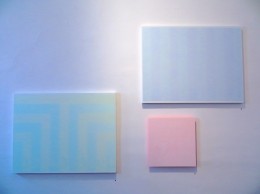 Norwegian artist Per Hess has done these very pale pastel paintings. (Notice the almost ghost stripes.)
Norwegian artist Per Hess has done these very pale pastel paintings. (Notice the almost ghost stripes.)
Light and colour have preoccupied Hess throughout his career. His palette is limited to variations on the primary colours, and they are subdued, as he draws on white to provide a surface for light to lift and animate his pale hues, which appear almost celestial.
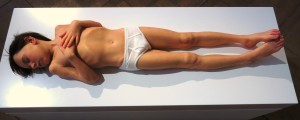

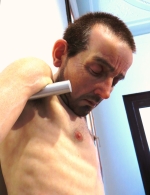 But Sam Jinks, a Melbourne-based artist, was my favorite, his hyper-realistic sculptures of people out of silicon being very close to my favorite, Ron Mueck.
But Sam Jinks, a Melbourne-based artist, was my favorite, his hyper-realistic sculptures of people out of silicon being very close to my favorite, Ron Mueck.
The process to produce most of these works is very similar. They begin as clay sculptures built up over an armature then they’re molded and cast in silicone. Once the cast is cleaned up I then poke the hairs into it and add a little final colour.
These metal circles in motion by German artist Heinz Mack.
In 1958 Heinz Mack and Otto Piene founded the ZERO movement …as a measurable climate the parameters light, structure, vibration, monochromatic are the determinants. Light as a method of design, just the same as brushstrokes and pigments, which adds rhythm to colour blobs and clumps, grooves and waves, nails and reflectors, cracks and diagonals. Structure as a conqueror of compositional hierarchies, as a possibility for interference and regularity beyond pure representation. Vibration as a result of a meeting between light and structure, as dynamisation of the picture and as movement which becomes whole in the eye of the beholder. Monochromatic as prerequisite for the purest, unclouded articulation of light, with a range from meditative sensation and vibration space up to radical colourless neutrality.
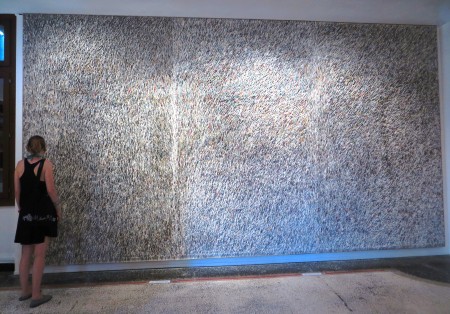
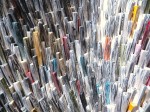 South Korean artist Suh Jeong Min’s Memories of Freedom Cries. Here is a detail from the huge triptych. (M. met him at Art Basel in Miami, acted like she could actually afford one of his pieces!)
South Korean artist Suh Jeong Min’s Memories of Freedom Cries. Here is a detail from the huge triptych. (M. met him at Art Basel in Miami, acted like she could actually afford one of his pieces!)
Suh builds up each artwork through an accumulation of discrete units of paper rolled into tubes or overlaid so that they resemble thin blocks of wood. Each one contains so many individual paper scraps compressed together that when they are cut by him their ends resemble the horizontal cross section of the trunk of a cut-down tree with its annual rings. These are affixed to the support by Suh with a rice-based glue in either a fairly ordered way, or more randomly to create specific visual effects. He cuts each piece by hand, eschewing machinery for the intentional imprecision of the personal touch.
The paper Suh uses is called hanji, and is made from the inner bark of Mulberry trees. This paper is usually formed into laminated sheets that are pounded to compact the wood fibers, giving it great resilience and durability.
It is in the unseen core of the paper units that Suh’s artwork generates its unique properties, for each scrap of paper comes from other artists’ discards. Traditional calligraphy and literati ink paintings on paper scrolls are cut up to make the paper units, and so their origin as artworks in their own right is subsumed into Suh work, like individuals gathered into a society.
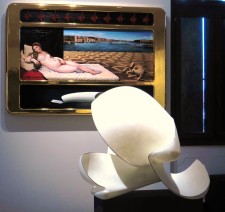 German artist Marc Fromm’s reclining woman in 3D. I guess he did the sculpture also, as it looks like the bottom painting.
German artist Marc Fromm’s reclining woman in 3D. I guess he did the sculpture also, as it looks like the bottom painting.
“In order to be able to understand reality and orient oneself within today’s day and age one must know the past,” says Marc Fromm. The origin of ideas and the critical awareness thereof are central ideas in the artist’s work.
So it seems to be a logical consequence that the recurring theme in his work is the adaptation of sculptures and paintings from past epochs. It is not only the art historical background or the temporal context of the respective role model work of art that move the artist to create his new interpretations, it is “the search for depth within the surface,” that guides him in his work. His work is consumed with our attitude towards reality. The observer is constantly confronted with his own perception of this reality.
Furthermore, all of his work adheres to certain mysteriousness. They fascinate, surprise or even embarrass – the ideal prerequisites for a fruitful examination of the work and its origin as well as for “the search for depth within the surface.
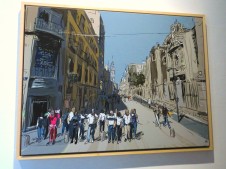 Herr Methorst, from the Netherlands, did this sketch/painting.
Herr Methorst, from the Netherlands, did this sketch/painting.
In 2009 he started the project StreetViewArt, sitting behind his computer, but traveling around the world with the help of Google Street View and painting what he sees. In his story, he travels thorough the concepts of time, space and existence, giving his view on art.3
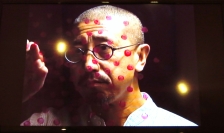 In a room hung with lightweight fabric, with tranquil music, we saw a video of Chinese artist Zhang Yu painting fingerprints on the screen.
In a room hung with lightweight fabric, with tranquil music, we saw a video of Chinese artist Zhang Yu painting fingerprints on the screen.
These paintings [of his Fingerprint Series] become a meditative process by repeatedly pressing his right index finger on rice paper with ink. Zhang limits his colors to shades of red, white and black, leaving thousands of overlapping fingerprints that create a unique infinite visual effect. He has created paintings, installations, books and performances with this process, making him a key figure in contemporary experimental ink painting.
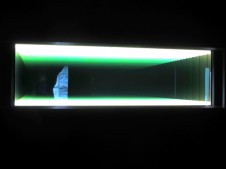
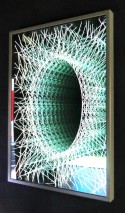 Chul Hyun Ahn’s light art. (Are both of these his?)
Chul Hyun Ahn’s light art. (Are both of these his?)
Chul Hyun Ahn is a member of a group of young light artists. [He] creates meditations on zen notions of the infinite and the void which distinguishes Ahn’s oeuvre from other artists working with light. Ahn’s multiple on-going sculpture series, including Tunnel Series, systematically explore the limitations of space and optics.
As is typical of Ahn’s work, he plays around with LED lights and mirrors creating a vortex effect sending you into infinite space.
A fascinating videoart, GOD, concept by Luce (Edmunds Lūcis), camera and montage, Raitis Vulfs. A woman makes a real child from clay. I couldn’t get a good photo, too much light reflection, but this is the video: http://www.youtube.com/watch?v=zhsq8mE9wAg
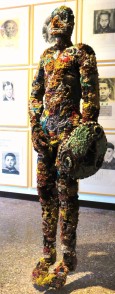 A Melbourne based artist, Selby Ginn’s Omnipresent Incarnate, larger than life.
A Melbourne based artist, Selby Ginn’s Omnipresent Incarnate, larger than life.
Selby Ginn’s shift in sculptural practice, to translating unwanted animal product into an abstracted simulation of human form, troubles any simple taxonomy. The multiplicity of this being’s source material — leather waste scraps cut into thousands of squares and woven together — gathers the materia prima into a single form by literally weaving the skin of many into one.4
See also her web site: http://selbyginn.com/
 Russian artist Dmitry Sherin’s I Believe in Angels.
Russian artist Dmitry Sherin’s I Believe in Angels.
…a series of large-scale sculptures, debates the concept of progress and the limits of the human body in the digital age. Our bodies are synchronized with technology, rendering the physical, animal form obsolete; it cannot keep up. From Leonardo Da Vinci to Felix Baumgartner, we have coveted the ability to fly, and Shorin is similarly seduced by the possibilities of flight. In this new work Shorin has created in his signature voyeur’s gaze a series of human flying machines. Drained of colour and placed in the heavens, Shorin’s airplane girls embody our newfound capabilities. In exploring definitions of beauty and the transcendental power of the feminine, Shorin assigns guardianship to womankind, giving an angel her wings in the most modern sense. Shorin looks to mass media images and revises clichéd ideals in mythical terms, placing the woman at the centre of our evolution as a species. In the assimilation of the industrial and the corporal, Shorin presents to the world a guardian angel for the information age.
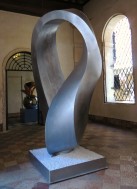 Bulgarian sculptor Plamen Yordanov’s Infinity (?), a brushed stainless steel sculpture from the series “Double Möbius Strip”. (He presently resides in the US.)
Bulgarian sculptor Plamen Yordanov’s Infinity (?), a brushed stainless steel sculpture from the series “Double Möbius Strip”. (He presently resides in the US.)
Infinity refers to several distinct concepts, linked to the idea of “without end” – which arise in philosophy, mathematics, and theology. The sculpture is based on the Möbius strip, which is a surface with only one side and only one boundary component.
Carole Feuerman’s life-sized swimmer, Monumental Queen, sculpted from bronze and stainless steel. We will see another swimmer of hers in a few days.
Feuerman is widely recognized for her series of bathers and swimmers, which she began in the late seventies. Rendered with exquisite detail from every eyelash, freckle, and water drop, her figures exude an inner sense of life, peace and sensuality.
These balls in the courtyard – Ivan by Scott Eady. I found the detail on the internet.
Scott Eady makes disruptive and troublesome sculpture that confounds expectations of the medium, unsettling the viewing experience through provocation, frustration or rogue humour. The painted bronze sculptures in this exhibition are part of a family of recent ‘blob’ works which have been variously placed, dropped or roped off in galleries or public spaces. These obdurate blobs offer a kind of full stop, a place where sculpture might confront its own histories, its contested place inside and outside gallery walls, and probe that often tense relationship between audiences and the sculptural object.Eady presents sculpture as prank, often calling on childhood games or tricks. As with other recent sculptures, Ivan has a solid bronze core slathered with thick layers of bright paint. While unsettling those fraught battles over the boundaries between painting and sculpture, here this material subterfuge primarily assists in prank-making. A hand-written ‘Kick Me’ note is stuck onto Ivan’s seemingly soft and gooey surface, setting a trap for anyone willing or gullible enough to take up its invitation.
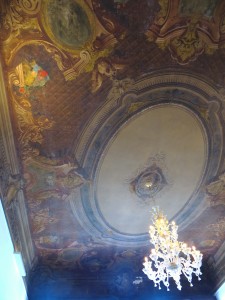 Note: we’re checking out all of this modern art on white walls which have been fitted into these palazzos, but the Murano glass chandeliers (ubiquitous) and the frescoed ceilings (ditto) are ignored. A few people noticed the handrails, however.
Note: we’re checking out all of this modern art on white walls which have been fitted into these palazzos, but the Murano glass chandeliers (ubiquitous) and the frescoed ceilings (ditto) are ignored. A few people noticed the handrails, however.
 Enough for now. Next blog will cover the afternoon.
Enough for now. Next blog will cover the afternoon.
1http://www.uncubemagazine.com/news/9675267
2http://aliciapatterson.org/stories/tatlin-who-moderna-museet
3http://herremethorst.pixpasites.com/#/la-biennale-di-venezia/philosophy
4http://dinheagney.com/writing/omnipresent-incarnate/
Tags: Art by Telephone, Ca' Corner della Regina, Fondazione Prada, Gilberto Zorio, Jannis Kounellis, Mario Merz, Rem Koolhas, Torches, Walter De Maria, Water Slips Down (Glass Igloo), When Attitudes Become Form: Bern 1969/Venice 2013
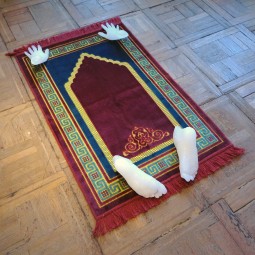
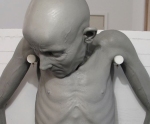
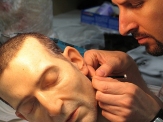
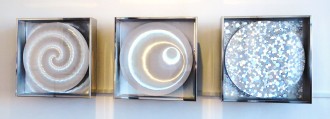
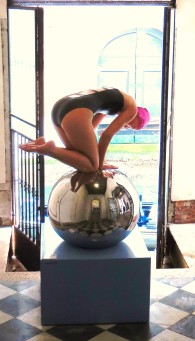
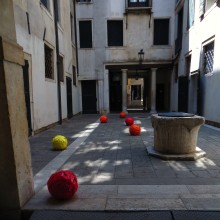
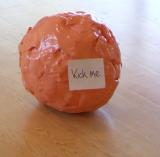
September 13, 2013 at 5:51 pm |
We would love to post the picture, Monumental Queen, along with your description at toemail.if you do not mind? We would post a link to your blog as well. http://toemail.wordpress.com
September 13, 2013 at 6:14 pm |
OK
September 13, 2013 at 6:14 pm
Thanks! Will let you know when it is posted.
September 15, 2013 at 11:47 am |
It’s posted now. Thanks so much, we really appreciate it!
🙂